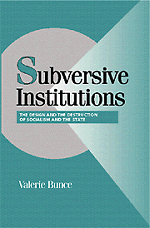Book contents
- Frontmatter
- Contents
- Preface
- 1 The Collapse of Socialism and Socialist States
- 2 Domestic Socialism: Monopoly and Deregulation
- 3 Federalism and the Soviet Bloc: Monopoly and Deregulation
- 4 Leaving Socialism
- 5 Leaving the State
- 6 Violent versus Peaceful State Dismemberment
- 7 Institutions and Opportunities: Constructing and Deconstructing Regimes and States
- Notes
- References
- Index
- Continuation of Series List
7 - Institutions and Opportunities: Constructing and Deconstructing Regimes and States
Published online by Cambridge University Press: 05 June 2012
- Frontmatter
- Contents
- Preface
- 1 The Collapse of Socialism and Socialist States
- 2 Domestic Socialism: Monopoly and Deregulation
- 3 Federalism and the Soviet Bloc: Monopoly and Deregulation
- 4 Leaving Socialism
- 5 Leaving the State
- 6 Violent versus Peaceful State Dismemberment
- 7 Institutions and Opportunities: Constructing and Deconstructing Regimes and States
- Notes
- References
- Index
- Continuation of Series List
Summary
Institutions constrain not only the ends to which behavior should be directed, but the means by which those ends are achieved. They provide individuals with the vocabularies of motives and with a sense of self. They generate not only that which is valued, but the rules by which it is calibrated and distributed.
Roger Friedland and Robert R. Alford (1991: 251)From mid-1989 to the close of 1992, state socialism collapsed in Eastern Europe and then in the Soviet Union; the Soviet bloc emptied and then formally dismantled; and the Yugoslav, Soviet, and Czechoslovak states dismembered. In a mere three and one-half years, virtually every defining feature of the postwar European landscape – and, thus, of the postwar international order – had been dramatically and irretrievably altered. To put the matter succinctly: there was, quite suddenly, one superpower instead of two; one Germany, not two; and one Europe (at least in the making) in the place of two. If the new Europe was reduced in these respects, however, it was also expanded in others, as twenty-two new states arose from the wreckage of Yugoslavia, the Soviet Union, and Czechoslovakia. Thus ended the remarkable forty-six-year run of stable state boundaries in Europe. With the war in Yugoslavia from 1991 to 1995, moreover, what also came to a close was the equally remarkable postwar “long peace,” a product in part of those stable state boundaries (see Gaddis, 1986; but see Bunce, 1993).
These dramatic events bring to the fore a number of important questions.
- Type
- Chapter
- Information
- Subversive InstitutionsThe Design and the Destruction of Socialism and the State, pp. 127 - 164Publisher: Cambridge University PressPrint publication year: 1999



